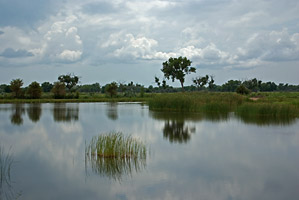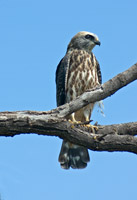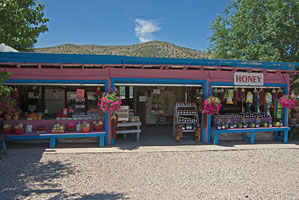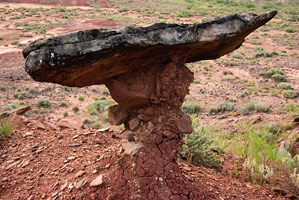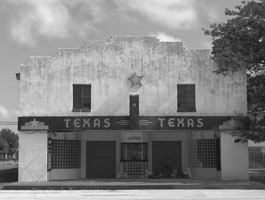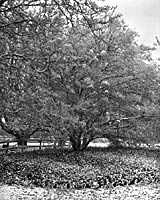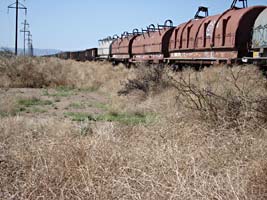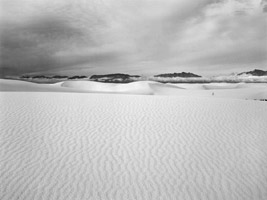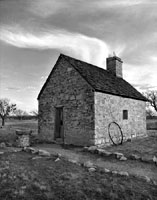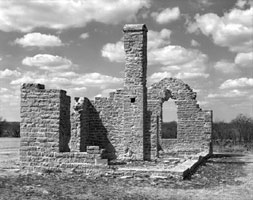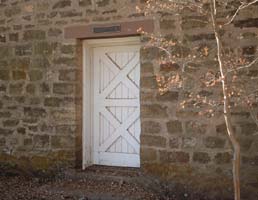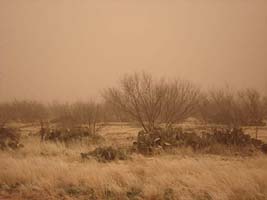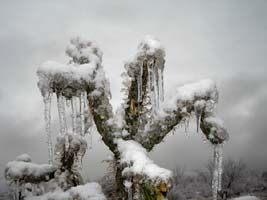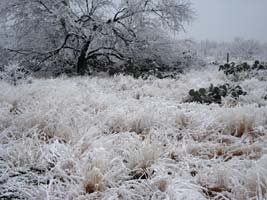
photoLog 2007
photoLog 2008
photoLog 2009
| Date: Wednesday, October 10, 2007 Topic: A Utopian Experiment Photo: Cape Cod in West Texas (click for larger version) --Pentax K10D, 16-45mm 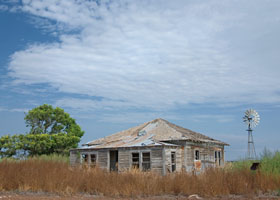 In the early 1900s, C.W. Post, inventor of
Postum and Post Toasties, developed a utopian colonization plan to
bring settlers/farmers to Garza County Texas. (more here)
Part of the plan involved furnishing potential settlers with a quarter
of a section (160 acres) and a house. As far as I know, all of
the houses were of the same "Cape Cod" style design. There
are still some standing although most of them have been modified from
the original design in various ways. Very few of these houses are
still occupied. In the early 1900s, C.W. Post, inventor of
Postum and Post Toasties, developed a utopian colonization plan to
bring settlers/farmers to Garza County Texas. (more here)
Part of the plan involved furnishing potential settlers with a quarter
of a section (160 acres) and a house. As far as I know, all of
the houses were of the same "Cape Cod" style design. There
are still some standing although most of them have been modified from
the original design in various ways. Very few of these houses are
still occupied. The original design included a domer. A dormer is a window for a room within the roof space that is built out at right angles to the main roof and has its own gable. The removal of this dormer seems a common modification, most likely because of roof leaks. In the house on the left, the dormer has been removed and the front porch has been enclosed to create an extra room. |
| Date: Wednesday, August
22,
2007 Topic: Photography Exhibit Photo: Souvenirs (click for larger version) --Pentax K10D, 50mm 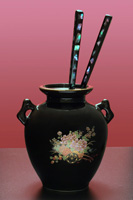 Eddie Jo and I will be part of a Caprock
Photographer’s Exhibit at the Garden and Art Center in Lubbock during
September. The title is “Passions Photographed” and exhibit
details and reception information are here. Eddie Jo and I will be part of a Caprock
Photographer’s Exhibit at the Garden and Art Center in Lubbock during
September. The title is “Passions Photographed” and exhibit
details and reception information are here.Eddie Jo always liked handtinting photographs with pencils and oils. Unfortunately, a side effect of my switch to digital output was that I could no longer print B&W on regular photo paper for her to handtint. So, as an alternative, she has begun trying her hand at using pastels on inkjet B&W images. Blending colors is much more difficult and the look is different, but, I think, quite interesting. She’ll be exhibiting some of her work: pastels of wildflowers on watercolor paper. Throughout the summer I changed my mind several times about my part of the exhibit and wound up having to work hard to finish. I finally decided to do something fun and different (or, at least, something I haven’t done in some time): studio still lifes in color. Sometimes a big change can help jump start your enthusiasm but I guess I forgot how much work a studio still life can be. |
| Date: Tuesday, July 3,
2007 Topic: Photographing in Southeastern New Mexico, Part II Photo: Meadow Below Monjeau Lookout (click for larger version) --Pentax K10D, 16-45mm 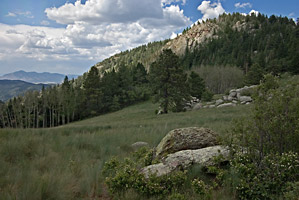 Ruidosa
may seem crowded, but most people are here to cool off, relax,
gamble or do things other
than outdoor photography. The
adjoining White Mountain Wilderness area is not usually
crowded, especially in the middle of the week, and has a lot of nice
hiking trails. For example, the forest service has a lookout on
top of Monjeau Peak (elevation: 10,356) that is reachable by a
maintained, but rough, dirt road. The image on the right is
a meadow just below the peak and is the trailhead for the Crest
Trail. The Capitan Range can be seen in the distance at the far
left and there are equally compelling views in other directions.
Eddie Jo, Duke and I were the only ones there on a Thursday
afternoon. It's one of my favorite places. Ruidosa
may seem crowded, but most people are here to cool off, relax,
gamble or do things other
than outdoor photography. The
adjoining White Mountain Wilderness area is not usually
crowded, especially in the middle of the week, and has a lot of nice
hiking trails. For example, the forest service has a lookout on
top of Monjeau Peak (elevation: 10,356) that is reachable by a
maintained, but rough, dirt road. The image on the right is
a meadow just below the peak and is the trailhead for the Crest
Trail. The Capitan Range can be seen in the distance at the far
left and there are equally compelling views in other directions.
Eddie Jo, Duke and I were the only ones there on a Thursday
afternoon. It's one of my favorite places.There are other nearby places nearby that might interest photographers. White Sands (see March 23 post below), Three Rivers Indian Petroglyphs, and Valley of Fires (see Sotol in Lava) are fairly short drives. Every outdoor photographer needs at least one sand dune image and I really like the possibilities offered by the lava flow although it doesn't appeal to everyone. In both cases, the right light is critical and you can't just show up and expect to get great images. The window of opportunity is pretty limited at the laval flow and if you are thinking about going there you might want to email me. |
| Date: Thursday, June 21,
2007 Topic: Southern New Mexico Photo: Church in San Patricio (click for larger version) --Pentax K10D, 16-45mm 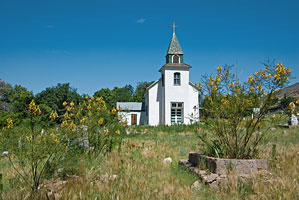
Around 15 years ago I photographed this church with a Mamiya 645. (see Church at San Patricio) At that time the church was obviously in a pretty bad state of repair. While the building is of considerable historic value, I thought at the time that it might actually be beyond repair or that repairs might simply not be economically feasible. I had heard since then that some repairs had been made and on a trip to southern New Mexico last week I stopped by and made the photograph on the right. Not only does the church have a new stucco and whitewash, unusually generous spring rains have given new life to the grounds. I was lucky enough to visit with Mr. Ray Sanchez who devotes a considerable amount of his time doing what he can for this building as well as taking care of a newer (1967) church the congergation now uses. This church is used only once a year around St. Patricks day. |
| Date: Wednesday, March 14, 2007 Topic: Photographing the "Traveling Jail" Photo: Jail in the Flats (click for larger version) --Pentax 67, 200mm, #8 yellow filter  Fort Griffin occupied the top of a hill.
On the bottomland between the fort and the Brazos River the town of
Fort Griffin, Texas grew up. It was commonly referred to as "the
flats." It was truly a "wild and wooly" western town populated by
off-duty soldiers, cattlemen, cowboys, buffalo hunters and all kinds of
undesirable characters. "The Flats" might have been a model for
some the towns you see in western movies. Fort Griffin occupied the top of a hill.
On the bottomland between the fort and the Brazos River the town of
Fort Griffin, Texas grew up. It was commonly referred to as "the
flats." It was truly a "wild and wooly" western town populated by
off-duty soldiers, cattlemen, cowboys, buffalo hunters and all kinds of
undesirable characters. "The Flats" might have been a model for
some the towns you see in western movies.I couldn't resist at least taking a record shot of the jail. It's probably the only remaining original building. In doing a quick bit of research I discoverd that it had once been moved to the nearby town of Albany. If fact, I came across a photograph of it in the city park there. I guess they decided to move it back. It doesn't look all that portable to me but it is obvious by comparing stones that it was moved intact. Weird, but maybe not as weird as putting bird baths in front of a courthouse that that has been vacant for 50 years. (see March 9th entry) |
| Date: Friday, March 9,
2007 Topic: Still a Ghost Town Photo: Clairmont Courthouse and Jail 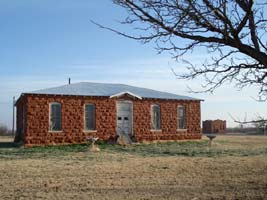 (click for larger version) --point and shoot digital About 15 years ago I made a photograph inside the jail at Clairmont, Texas. I pass through here every few months in a hurry to get to Dallas or back home and always take a quick glance to see if anything has changed. Yesterday, on a more leisurely photography trip, I decided to stop for a closer look. It looks as though the courthouse roof has been replaced. I could be wrong, but it looks as though a couple of bird baths have been placed out front. At least I don't remember them being there before. ( Bird baths? Your guess is a good as mine. Anyway, it made me smile.) Otherwise, not a lot has changed. Clairmont is still a ghost town. The jail is the small building to the right of the courthouse. It used to be unlocked, but idiot graffiti artists have undoubtedly caused someone to change that. That's sad. Every year there are fewer places where the public can take an unencumbered look at history. Places are either off limits or there are signs everywhere telling you what you can and can't do and the place loses all of its charm. Buildings like the jail and courthouse present a dilemma. How much can you afford to spend of keeping up buildings that are only of (minor?) historical value when budgets are tight? |
photoLog 2008
photoLog 2009

